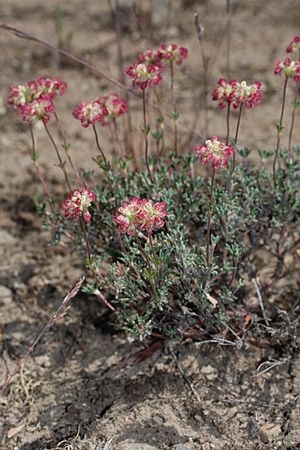Thymeleaf wild buckwheat facts for kids
Quick facts for kids Thymeleaf wild buckwheat |
|
|---|---|
 |
|
| Scientific classification | |
| Genus: |
Eriogonum
|
| Species: |
thymoides
|
Eriogonum thymoides, also known as thymeleaf wild buckwheat, is a common flowering plant. It belongs to the buckwheat family. This plant is a type of species that grows in many places.
Contents
Where Thymeleaf Buckwheat Lives
This plant is native to the Pacific Northwest region of the United States. You can find it in Idaho, Oregon, and Washington. There are three main groups of these plants in these states.
Thymeleaf buckwheat likes to grow in specific places. It often lives in areas with sagebrush. You can also find it in open spots within ponderosa pine forests. It also grows on mountain ridges.
What Thymeleaf Buckeleaf Looks Like
This plant is a small shrub, which means it's like a tiny bush. It can grow up to 30 to 40 centimeters wide. That's about the size of a ruler and a half! The plant is covered in soft, woolly, or silky hairs.
Its leaves are small, measuring up to 1.5 centimeters long. They can be flat or slightly rolled. The plant also grows straight flowering stems. These stems can reach about 12 centimeters tall. Each stem has a ring of small leaf-like parts called bracts around its middle.
At the top of each stem, there's a cluster of flowers. This cluster is called an inflorescence and can be up to 2 centimeters wide. The individual flowers are small, about a centimeter long. They can be white, yellow, or even pink!
How Thymeleaf Buckwheat Reproduces
Thymeleaf buckwheat has an interesting way of reproducing. Some plants have both male and female flower parts. Other plants might have only male parts or only female parts. This helps the plant make new seeds and grow more plants.
Why Thymeleaf Buckwheat is Important
This plant is very important for nature. It provides "special value to native bees." This means that bees love to visit its flowers. They collect nectar and pollen, which helps them and also helps the plant make seeds. Bees are super important for our environment!

